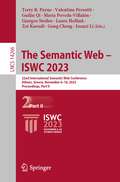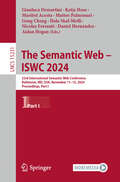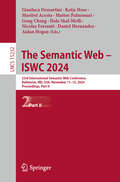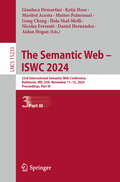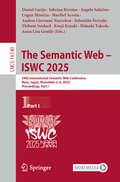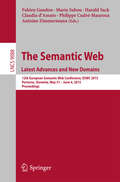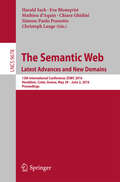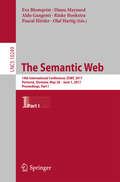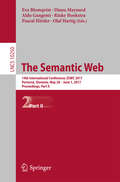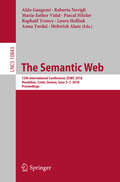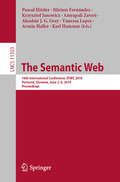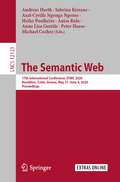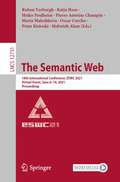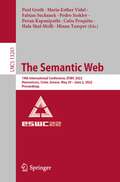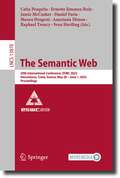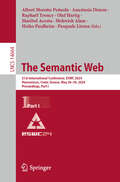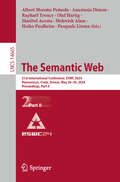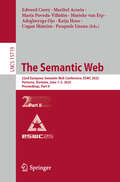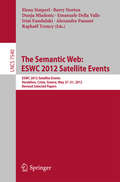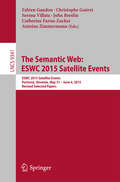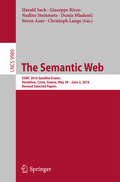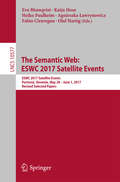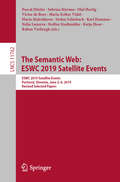- Table View
- List View
The Semantic Web – ISWC 2023: 22nd International Semantic Web Conference, Athens, Greece, November 6–10, 2023, Proceedings, Part II (Lecture Notes in Computer Science #14266)
by Valentina Presutti Guilin Qi Juanzi Li María Poveda-Villalón Laura Hollink Giorgos Stoilos Zoi Kaoudi Terry R. Payne Gong ChengThis book constitutes the proceedings of the 22nd International Semantic Web Conference, ISWC 2023, which took place in October 2023 in Athens, Greece. The 58 full papers presented in this double volume were thoroughly reviewed and selected from 248 submissions. Many submissions focused on the use of reasoning and query answering, witha number addressing engineering, maintenance, and alignment tasks for ontologies. Likewise, there has been a healthy batch of submissions on search, query, integration, and the analysis of knowledge. Finally, following the growing interest in neuro-symbolic approaches, there has been a rise in the number of studies that focus on the use of Large Language Models and Deep Learning techniques such as Graph Neural Networks.
The Semantic Web – ISWC 2024: 23rd International Semantic Web Conference, Baltimore, MD, USA, November 11–15, 2024, Proceedings, Part I (Lecture Notes in Computer Science #15231)
by Katja Hose Daniel Hernández Aidan Hogan Maribel Acosta Hala Skaf-Molli Matteo Palmonari Gong Cheng Gianluca Demartini Nicolas FerrantiThis three-volume set constitutes the proceedings of the 23rd International Semantic Web Conference, ISWC 2023, held in Hanover, MD, USA, during November 11-15, 2024. The 44 full papers presented in these proceedings were carefully reviewed and selected from 155 submissions. This conference focuses on research on the Semantic Web, including benchmarks, knowledge graphs, tools and vocabularies.
The Semantic Web – ISWC 2024: 23rd International Semantic Web Conference, Baltimore, MD, USA, November 11–15, 2024, Proceedings, Part II (Lecture Notes in Computer Science #15232)
by Katja Hose Daniel Hernández Aidan Hogan Maribel Acosta Hala Skaf-Molli Matteo Palmonari Gong Cheng Gianluca Demartini Nicolas FerrantiThis three-volume set constitutes the proceedings of the 23rd International Semantic Web Conference, ISWC 2023, held in Hanover, MD, USA, during November 11-15, 2024. The 44 full papers presented in these proceedings were carefully reviewed and selected from 155 submissions. This conference focuses on research on the Semantic Web, including benchmarks, knowledge graphs, tools and vocabularies.
The Semantic Web – ISWC 2024: 23rd International Semantic Web Conference, Baltimore, MD, USA, November 11–15, 2024, Proceedings, Part III (Lecture Notes in Computer Science #15233)
by Katja Hose Daniel Hernández Aidan Hogan Maribel Acosta Hala Skaf-Molli Matteo Palmonari Gong Cheng Gianluca Demartini Nicolas FerrantiThis three-volume set constitutes the proceedings of the 23rd International Semantic Web Conference, ISWC 2023, held in Hanover, MD, USA, during November 11-15, 2024. The 44 full papers presented in these proceedings were carefully reviewed and selected from 155 submissions. This conference focuses on research on the Semantic Web, including benchmarks, knowledge graphs, tools and vocabularies. Chapter “Data Privacy Vocabulary (DPV) – Version 2.0” is available open access under a Creative Commons Attribution 4.0 International License via link.springer.com.
The Semantic Web – ISWC 2025: 24th International Semantic Web Conference, Nara, Japan, November 2–6, 2025, Proceedings, Part I (Lecture Notes in Computer Science #16140)
by Kouji Kozaki Hideaki Takeda Anna Lisa Gentile Andrea Giovanni Nuzzolese Sabrina Kirrane Maribel Acosta Cogan Shimizu Daniel Garijo Angelo Salatino Sebastián Ferrada Thibaut SoulardThis two-volume set constitutes the proceedings of the 24th International Semantic Web Conference, ISWC 2025, held in Nara, Japan, during November 2–6, 2025. The 60 full papers included in these volumes were carefully reviewed and selected from 277 submissions. These papers address theoretical, analytical, and empirical aspects of the Semantic Web; promote the sharing of resources that support, enable, or utilize semantic web research; and describe applied research as well as software tools, systems, or architectures that benefit from the use of Semantic Web and Knowledge Graph technologies.
The Semantic Web. Latest Advances and New Domains
by Harald Sack Fabien Gandon Antoine Zimmermann Claudia D'Amato Marta Sabou Philippe Cudré-MaurouxThis book constitutes the refereed proceedings of the 12th Extended Semantic Web Conference, ESWC 2014, held in Anissaras, Portoroz, Slovenia, in May/June 2015. The 43 revised full papers presented together with three invited talks were carefully reviewed and selected from 164 submissions. This program was completed by a demonstration and poster session, in which researchers had the chance to present their latest results and advances in the form of live demos. In addition, the PhD Symposium program included 12 contributions, selected out of 16 submissions. The core tracks of the research conference were complemented with new tracks focusing on linking machine and human computation at web scale (cognition and Semantic Web, Human Computation and Crowdsourcing) beside the following subjects Vocabularies, Schemas, Ontologies, Reasoning, Linked Data, Semantic Web and Web Science, Semantic Data Management, Big data, Scalability, Natural Language Processing and Information Retrieval, Machine Learning, Mobile Web, Internet of Things and Semantic Streams, Services, Web APIs and the Web of Things, Cognition and Semantic Web, Human Computation and Crowdsourcing and In-Use Industrial Track as well.
The Semantic Web. Latest Advances and New Domains
by Christoph Lange Harald Sack Mathieu D'Aquin Eva Blomqvist Chiara Ghidini Simone Paolo PonzettoThe 47 revised full papers presented together with three invited talks were carefully reviewed and selected from 204 submissions. This program was completed by a demonstration and poster session, in which researchers had the chance to present their latest results and advances in the form of live demos. In addition, the PhD Symposium program included 10 contributions, selected out of 21 submissions. The core tracks of the research conference were complemented with new tracks focusing on linked data; machine learning; mobile web, sensors and semantic streams; natural language processing and information retrieval; reasoning; semantic data management, big data, and scalability; services, APIs, processes and cloud computing; smart cities, urban and geospatial data; trust and privacy; and vocabularies, schemas, and ontologies.
The Semantic Web: 14th International Conference, ESWC 2017, Portorož, Slovenia, May 28 – June 1, 2017, Proceedings, Part I (Lecture Notes in Computer Science #10249)
by Eva Blomqvist Aldo Gangemi Diana Maynard Rinke Hoekstra Pascal Hitzler Olaf HartigThe two volumes LNCS 10249 and 10250 constitute the refereed proceedings of the 14th International Semantic Web Conference, ESWC 2017, held in Portorož, Slovenia.The 51 revised full papers presented were carefully reviewed and selected from 183 submissions. In addition, 10 PhD papers are included, selected out of 14 submissions. The papers are organized in the following tracks: semantic data management, big data, and scalability; linked data; machine learning; mobile web, sensors, and semantic streams; natural language processing and information retrieval; vocabularies, schemas, and ontologies; reasoning; social web and web science; semantic web and transparency; in use and industrial track; and PhD symposium.The paper 'Linked Data Notifications: A Resource-Centric Communication Protocol' is published open access under a CC BY 4.0 license at link.springer.com.
The Semantic Web: 14th International Conference, ESWC 2017, Portorož, Slovenia, May 28 – June 1, 2017, Proceedings, Part II (Lecture Notes in Computer Science #10250)
by Eva Blomqvist Aldo Gangemi Diana Maynard Rinke Hoekstra Pascal Hitzler Olaf HartigThe two volumes LNCS 10249 and 10250 constitute the refereed proceedings of the 14th International Semantic Web Conference, ESWC 2017, held in Portorož, Slovenia.The 51 revised full papers presented were carefully reviewed and selected from 183 submissions. In addition, 10 PhD papers are included, selected out of 14 submissions. The papers are organized in the following tracks: semantic data management, big data, and scalability; linked data; machine learning; mobile web, sensors, and semantic streams; natural language processing and information retrieval; vocabularies, schemas, and ontologies; reasoning; social web and web science; semantic web and transparency; in use and industrial track; and PhD symposium.
The Semantic Web: 15th International Conference, ESWC 2018, Heraklion, Crete, Greece, June 3–7, 2018, Proceedings (Lecture Notes in Computer Science #10843)
by Anna Tordai Maria-Esther Vidal Aldo Gangemi Raphaël Troncy Pascal Hitzler Roberto Navigli Laura Hollink Mehwish AlamThis book constitutes the refereed proceedings of the 15th International Semantic Web Conference, ESWC 2018, held in Heraklion, Crete, Greece.The 48 revised full papers presented were carefully reviewed and selected from 179 submissions. The papers cover a large range of topics such as logical modelling and reasoning, natural language processing, databases and data storage and access, machine learning, distributed systems, information retrieval and data mining, social networks, and Web science and Web engineering.
The Semantic Web: 16th International Conference, ESWC 2019, Portorož, Slovenia, June 2–6, 2019, Proceedings (Lecture Notes in Computer Science #11503)
by Armin Haller Pascal Hitzler Miriam Fernández Krzysztof Janowicz Amrapali Zaveri Alasdair J. G. Gray Vanessa Lopez Karl HammarThis book constitutes the refereed proceedings of the 16th International Semantic Web Conference, ESWC 2019, held in Portorož, Slovenia. The 39 revised full papers presented were carefully reviewed and selected from 134 submissions. The papers are organized in three tracks: research track, resources track, and in-use track and deal with the following topical areas: distribution and decentralisation, velocity on the Web, research of research, ontologies and reasoning, linked data, natural language processing and information retrieval, semantic data management and data infrastructures, social and human aspects of the Semantic Web, and, machine learning.
The Semantic Web: 17th International Conference, ESWC 2020, Heraklion, Crete, Greece, May 31–June 4, 2020, Proceedings (Lecture Notes in Computer Science #12123)
by Heiko Paulheim Axel-Cyrille Ngonga Ngomo Anna Lisa Gentile Sabrina Kirrane Andreas Harth Anisa Rula Peter Haase Michael CochezThis book constitutes the refereed proceedings of the 17th International Semantic Web Conference, ESWC 2020, held in Heraklion, Crete, Greece.* The 39 revised full papers presented were carefully reviewed and selected from 166 submissions. The papers were submitted to three tracks: the research track, the resource track and the in-use track. These tracks showcase research and development activities, services and applications, and innovative research outcomes making their way into industry. The research track caters for both long standing and emerging research topics in the form of the following subtracks: ontologies and reasoning; natural language processing and information retrieval; semantic data management and data infrastructures; social and human aspects of the Semantic Web; machine learning; distribution and decentralization; science of science; security, privacy, licensing and trust; knowledge graphs; and integration, services and APIs.*The conference was held virtually due to the COVID-19 pandemic.Chapter ‘Piveau: A Large-scale Oopen Data Management Platform based on Semantic Web Technologies’ is available open access under a Creative Commons Attribution 4.0 International License via link.springer.com.
The Semantic Web: 18th International Conference, ESWC 2021, Virtual Event, June 6–10, 2021, Proceedings (Lecture Notes in Computer Science #12731)
by Ruben Verborgh Oscar Corcho Heiko Paulheim Katja Hose Mehwish Alam Maria Maleshkova Pierre-Antoine Champin Petar RistoskiThis book constitutes the refereed proceedings of the 18th International Semantic Web Conference, ESWC 2021, held virtually in June 2021. The 41 full papers and 2 short papers presented were carefully reviewed and selected from 167 submissions. The papers were submitted to three tracks: the research track, the resource track and the in-use track. These tracks showcase research and development activities, services and applications, and innovative research outcomes making their way into industry. The research track caters to both long-standing and emerging research topics in the form of the following subtracks: ontologies and reasoning; knowledge graphs (understanding, creating, and exploiting); semantic data management, querying and distributed data; data dynamics, quality, and trust; matching, integration, and fusion; NLP and information retrieval; machine learning; science data and scholarly communication; and problems to solve before you die.
The Semantic Web: 19th International Conference, ESWC 2022, Hersonissos, Crete, Greece, May 29 – June 2, 2022, Proceedings (Lecture Notes in Computer Science #13261)
by Paul Groth Maria-Esther Vidal Fabian Suchanek Pedro Szekley Pavan Kapanipathi Catia Pesquita Hala Skaf-Molli Minna TamperThis book constitutes the refereed proceedings of the 19th International Semantic Web Conference, ESWC 2022, held in Hersonissos, Crete, Greece in May/June 2022. The 28 full papers presented were carefully reviewed and selected from 119 submissions. The papers are covering subjects related to semantic technologies, ranging from deep learning and knowledge graphs to integration for software development and ontologies. The quality of the accepted papers put the maturity level reached by the Semantic Web technologies into perspective. They provide evidence of the impact of these technologies in areas like data management, question answering, reasoning, programming languages, and machine learning.
The Semantic Web: 20th International Conference, ESWC 2023, Hersonissos, Crete, Greece, May 28–June 1, 2023, Proceedings (Lecture Notes in Computer Science #13870)
by Raphael Troncy Mauro Dragoni Ernesto Jimenez-Ruiz Anastasia Dimou Catia Pesquita Jamie McCusker Daniel Faria Sven HertlingThis book constitutes the refereed proceedings of the 20th International Conference onThe Semantic Web, ESWC 2023, held in Hersonissos, Crete, Greece, during May 28–June 1, 2023.The 41 full papers included in this book were carefully reviewed and selected from 167 submissions. They are organized in topical sections as follows: research, resource and in-use.
The Semantic Web: 21st International Conference, ESWC 2024, Hersonissos, Crete, Greece, May 26–30, 2024, Proceedings, Part I (Lecture Notes in Computer Science #14664)
by Heiko Paulheim Raphaël Troncy Olaf Hartig Mehwish Alam Maribel Acosta Anastasia Dimou Pasquale Lisena Albert Meroño PeñuelaThe two-volume set LNCS 14664 and 14665 constitutes the refereed proceedings of the 21st International Conference on The Semantic Web, ESWC 2024, held in Hersonissos, Crete, Greece, during May 26-30, 2024. The 32 full papers presented were carefully reviewed and selected from 138 submissions. They focus on all aspects of theoretical, analytical, and empirical aspects of the semantic web, semantic technologies, knowledge graphs and semantics on the web in general.
The Semantic Web: 21st International Conference, ESWC 2024, Hersonissos, Crete, Greece, May 26–30, 2024, Proceedings, Part II (Lecture Notes in Computer Science #14665)
by Heiko Paulheim Raphaël Troncy Olaf Hartig Mehwish Alam Maribel Acosta Anastasia Dimou Pasquale Lisena Albert Meroño PeñuelaThe two-volume set LNCS 14664 and 14665 constitutes the refereed proceedings of the 21st International Conference on The Semantic Web, ESWC 2024, held in Hersonissos, Crete, Greece, during May 26-30, 2024. The 32 full papers presented were carefully reviewed and selected from 138 submissions. They focus on all aspects of theoretical, analytical, and empirical aspects of the semantic web, semantic technologies, knowledge graphs and semantics on the web in general.
The Semantic Web: 22nd European Semantic Web Conference, ESWC 2025, Portoroz, Slovenia, June 1–5, 2025, Proceedings, Part I (Lecture Notes in Computer Science #15718)
by Edward Curry Adegboyega Ojo Marieke Van Erp Katja Hose Maribel Acosta Pasquale Lisena Maria Poveda-Villalón Cogan ShimizuThis two-volume set LNCS 15718-15719 constitutes the refereed proceedings of the 22nd European Semantic Web Conference, ESWC 2025, held in Portoroz, Slovenia, during June 1–5, 2025.The 45 full papers presented were carefully reviewed and selected from 155 submissions.The ESWC&’s Research track addresses the theoretical, analytical, and empirical aspects of the semantic web, semantic technologies, knowledge graphs and semantics on the Web in general. The In-use track focuses on contributions that reuse and apply state-of-the-art semantic technologies or resources to real-world settings. The resource track deals with resource contributions that are, on the one hand innovative or novel, and on the other hand sharable and reusable (e.g. datasets, knowledge graphs, ontologies, workflows, benchmarks, frameworks), and provide the necessary scaffolding to support the generation of scientific work and advance the state of the art.
The Semantic Web: 22nd European Semantic Web Conference, ESWC 2025, Portoroz, Slovenia, June 1–5, 2025, Proceedings, Part II (Lecture Notes in Computer Science #15719)
by Edward Curry Adegboyega Ojo Marieke Van Erp Katja Hose Maribel Acosta Pasquale Lisena Maria Poveda-Villalón Cogan ShimizuThis two-volume set LNCS 15718-15719 constitutes the refereed proceedings of the 22nd European Semantic Web Conference, ESWC 2025, held in Portoroz, Slovenia, during June 1–5, 2025.The 45 full papers presented were carefully reviewed and selected from 155 submissions.The ESWC&’s Research track addresses the theoretical, analytical, and empirical aspects of the semantic web, semantic technologies, knowledge graphs and semantics on the Web in general. The In-use track focuses on contributions that reuse and apply state-of-the-art semantic technologies or resources to real-world settings. The resource track deals with resource contributions that are, on the one hand innovative or novel, and on the other hand sharable and reusable (e.g. datasets, knowledge graphs, ontologies, workflows, benchmarks, frameworks), and provide the necessary scaffolding to support the generation of scientific work and advance the state of the art.
The Semantic Web: ESWC 2012 Satellite Events
by Emanuele Della Valle Elena Simperl Barry Norton Dunja Mladenic Irini Fundulaki Alexandre Passant Raphaël TroncyThis book constitutes the thoroughly refereed post-proceedings of the satellite events of the 9th International Conference on the Semantic Web, ESWC 2012, held in Heraklion, Crete, Greece, in May 2012. This volume contains 49 full papers and 13 short papers describing the posters and demonstrations. (SUGGESTION/ HELP needed).
The Semantic Web: ESWC 2014 Satellite Events
by Raphael Troncy Harald Sack Valentina Presutti Anna Tordai Eva Blomqvist Ioannis PapadakisThis book constitutes the thoroughly refereed post-conference proceedings of the Satellite Events of the 11th International Conference on the Semantic Web, ESWC 2014, held in Anissaras, Crete, Greece, in May 2014. The volume contains 20 poster and 43 demonstration papers, selected from 113 submissions, as well as 12 best workshop papers selected from 60 papers presented at the workshop at ESWC 2014. Best two papers from AI Mashup Challenge are also included. The papers cover various aspects of the Semantic Web.
The Semantic Web: ESWC 2015 Satellite Events, Portorož, Slovenia, May 31 – June 4, 2015, Revised Selected Papers (Lecture Notes in Computer Science #9341)
by Fabien Gandon Antoine Zimmermann Christophe Guéret Serena Villata John Breslin Catherine Faron-ZuckerThis book constitutes the thoroughly refereed post-conference proceedings of the Satellite Events of the 12th European Conference on the Semantic Web, ESWC 2015, held in Portorǒz, Slovenia, in May/June 2015. The volume contains 12 poster and 22 demonstration papers, selected from 50 submissions, as well as 22 best workshop papers selected from 140 papers presented at the 16 workshops that took place at ESWC 2015. The papers cover various aspects of the semantic web.
The Semantic Web: ESWC 2016 Satellite Events, Heraklion, Crete, Greece, May 29 – June 2, 2016, Revised Selected Papers (Lecture Notes in Computer Science #9989)
by Christoph Lange Harald Sack Sören Auer Giuseppe Rizzo Nadine Steinmetz Dunja MladenićThis book constitutes the thoroughly refereed post-conference proceedings of the Satellite Events of the 13th European Conference on the Semantic Web, ESWC 2016, held in Heraklion, Greece, in May/June 2016.The volume contains 16 full papers and 38 poster and demonstration papers, carefully selected from 12 workshops focusing on specific research issues related to the Semantic Web.
The Semantic Web: ESWC 2017 Satellite Events, Portorož, Slovenia, May 28 – June 1, 2017, Revised Selected Papers (Lecture Notes in Computer Science #10577)
by Agnieszka Ławrynowicz Heiko Paulheim Eva Blomqvist Olaf Hartig Katja Hose Fabio CiravegnaThis book constitutes the thoroughly refereed post-conference proceedings of the Satellite Events of the 14th European Conference on the Semantic Web, ESWC 2017, held in Portoroz, Slovenia, in May/June 2017. The volume contains 8 poster and 24 demonstration papers, selected from 105 submissions. Additionally, this book includes a selection of 13 best workshop papers. The papers cover various aspects of the semantic web.
The Semantic Web: ESWC 2019 Satellite Events, Portorož, Slovenia, June 2–6, 2019, Revised Selected Papers (Lecture Notes in Computer Science #11762)
by Ruben Verborgh Maria-Esther Vidal Stefan Schlobach Pascal Hitzler Olaf Hartig Katja Hose Maria Maleshkova Karl Hammar Sabrina Kirrane Victor De Boer Nelia Lasierra Steffen StadtmüllerThis book constitutes the thoroughly refereed post-conference proceedings of the Satellite Events of the 16th Extended Semantic Web Conference, ESWC 2019, held in Portorož, Slovenia, in June 2019.The volume contains 38 poster and demonstration papers, 2 workshop papers,5 PhD symposium papers, and 3 industry track papers, selected out of a total of 68 submissions. They deal with all areas of semantic web research, semantic technologies on the Web and Linked Data.
